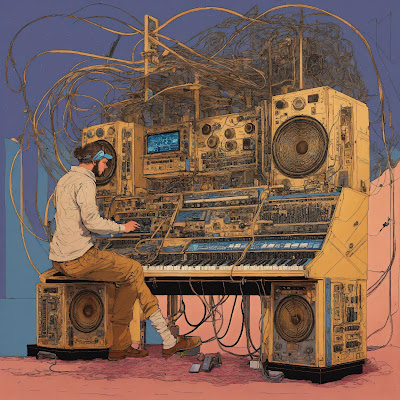The fractals are coming.
New study reveals brain's fractal-like structure near phase transition, a finding that may be universal across species
Jun 2024, phys.org
Now, a new Northwestern University study has discovered that the brain's structural features reside in the vicinity of a similar critical point - either at or close to a structural phase transition. Surprisingly, these results are consistent across brains of humans, mice and fruit flies, which suggests the finding might be universal.Although the researchers don't know between which phases the brain's structure is transitioning, they say this new information could enable new designs for computational models of the brain's complexity and emergent phenomena.Brain cells are arranged in a fractal-like statistical pattern at different scales. Self-similarity, long-range correlations and broad size distributions are all signatures of a critical state, where features are neither too organized nor too random."These are things we see in all critical systems in physics"The researchers were amazed to find that all brain samples studied—from humans, mice and fruit flies—have consistent critical exponents across organisms, meaning they share the same quantitative features of criticality. The underlying, compatible structures among organisms hint that a universal governing principle might be at play.
via Northwestern University Weinberg College of Arts and Sciences: Helen S. Ansell et al, Unveiling universal aspects of the cellular anatomy of the brain, Communications Physics (2024). DOI: 10.1038/s42005-024-01665-y
Image credit: Cross section of European beach grass Ammophila arenaria leaf - Gerhard Vlcek Nikon Small World 7th Place - 2024 [link]
Can a computer chip have zero energy loss in 1.58 dimensions?
Jul 2024, phys.org
Many states without energy loss might exist somewhere in between one and two dimensions. At 1.58 dimensions - By growing a chemical element (bismuth) on top of a semiconductor (indium antimonide), the scientists in China obtained fractal structures that were spontaneously formed, upon varying the growth conditions. The scientists in Utrecht then theoretically showed that, from these structures, zero-dimensional corner modes and lossless one-dimensional edge states emerged."The fractals behave like two dimensional topological insulators at finite energies and at the same time exhibit, at zero energy, a state at its corners that could be used as a qubit, the building blocks of quantum computers. Hence, the discovery opens new paths to the long-wished qubits."In follow-up research, the experimental group in China will try to grow a superconductor on top of the fractal structure. These fractals have many holes, and there are lossless currents running around many of them. Those could be used for energy efficient processing of information. They also exhibit zero-energy modes at their corners, thus combining the best of the one-dimensional and two-dimensional worlds. "If this works, it might reveal even more unexpected secrets hidden at dimension 1.58."
via the QuMAT consortium at Utrecht University and Shanghai Jiao Tong University: Canyellas, R., et al. Topological edge and corner states in bismuth fractal nanostructures. Nature Physics (2024). DOI: 10.1038/s41567-024-02551-8
Required Post Script:
If you didn't think you'd be getting an obligatory Isaac Asimov lesson here then I don't know where you think you are: Isaac Asimov wrote a story called Robot Dreams, and that's where we get our Laws of Robotics. Seriously, and this is why science and art need each other to continue to be relevant to humans. In the story, a robot named Elvex (LVX-1) is updated with "fractal geometry" because they thought it would "produce a brain pattern with more complexity, possibly closer to that of a human". The robot begins to dream about self-preservation, in direct opposition to the Laws of Robots, and is subsequently killed ("killed").
Physicists explain how fractional charge in pentalayer graphene could work
Nov 2024, phys.org
Fractal Man, explained:
They found that the moiré arrangement of pentalayer graphene, in which each lattice-like layer of carbon atoms is arranged atop the other and on top of the boron-nitride, induces a weak electrical potential. When electrons pass through this potential, they form a sort of crystal, or a periodic formation, that confines the electrons and forces them to interact through their quantum correlations.This electron tug-of-war creates a sort of cloud of possible physical states for each electron, which interacts with every other electron cloud in the crystal, in a wavefunction, or a pattern of quantum correlations, that gives the winding that should set the stage for electrons to split into fractions of themselves."This is a completely new mechanism, meaning in the decades-long history, people have never had a system go toward these kinds of fractional electron phenomena."
Note: Two other research teams - one from Johns Hopkins University, and the other from Harvard University, the University of California at Berkeley, and Lawrence Berkeley National Laboratory - have each published similar results in the same issue.
via MIT: Zhihuan Dong et al, Theory of Quantum Anomalous Hall Phases in Pentalayer Rhombohedral Graphene Moiré Structures, Physical Review Letters (2024). DOI: 10.1103/PhysRevLett.133.206502.

















